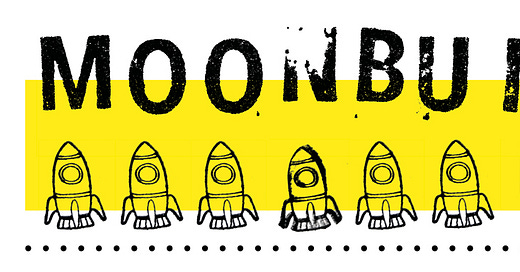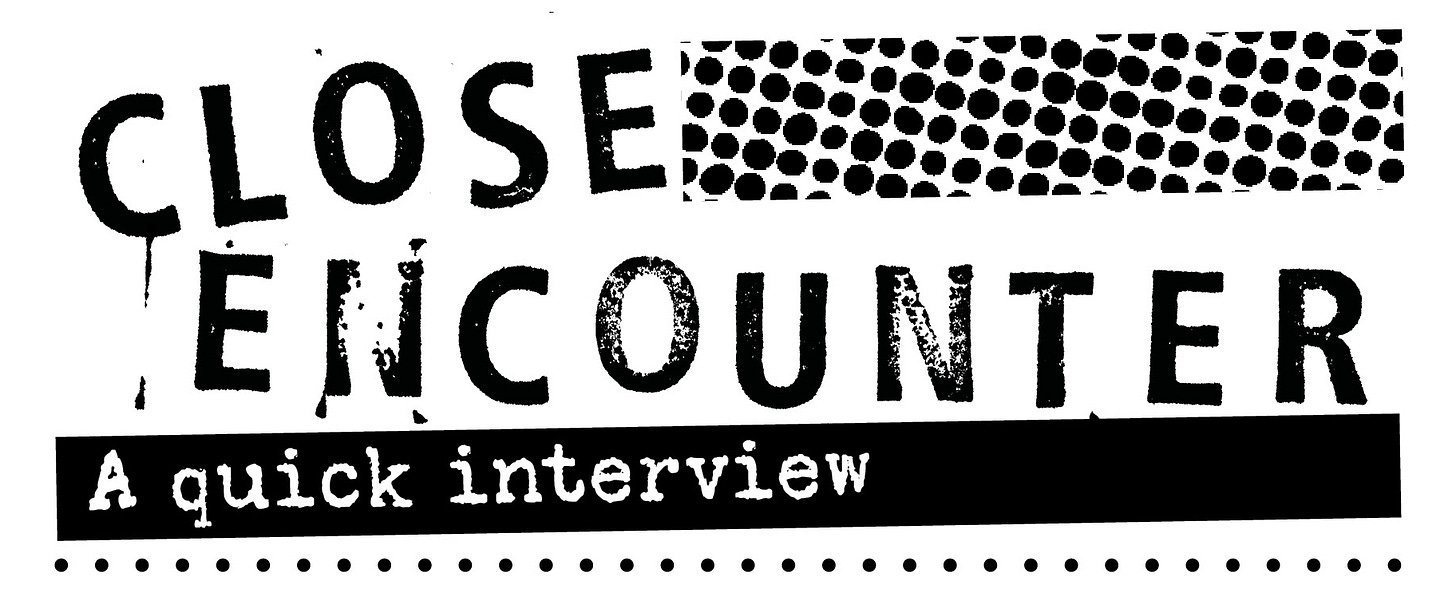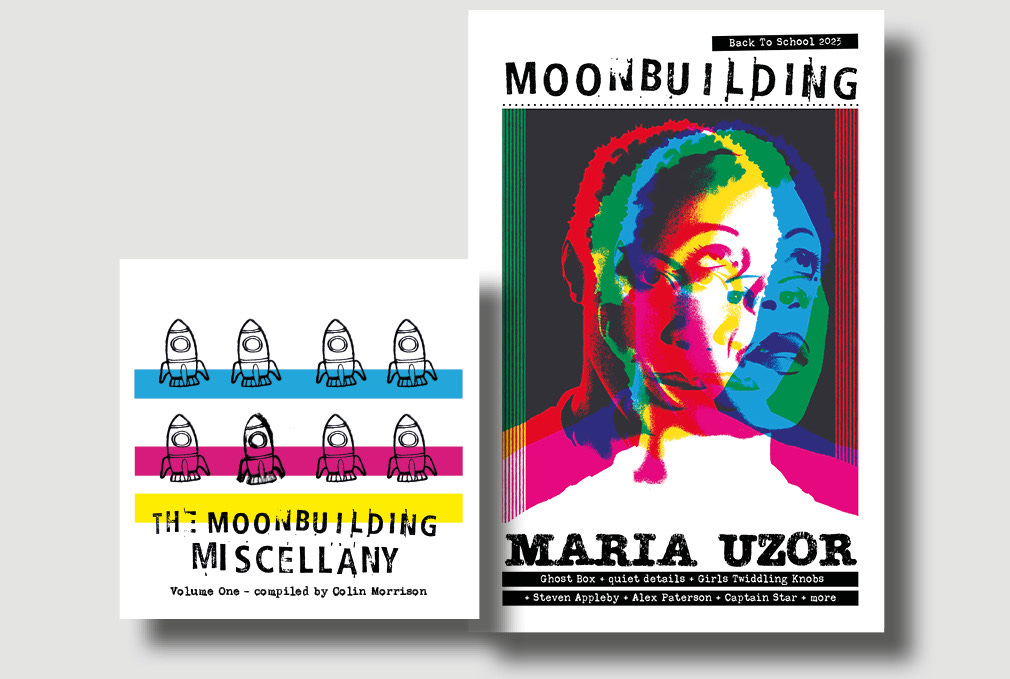Simon Reynolds Special / 11 April 2024
A Book Of The Week edition of your new favourite weekly newsletter
Don’t panic! It is only Thursday, not Friday quite yet, thankfully… I’ve not finished writing the regular Moonbuilding Weekly, but that will be with you tomorrow bursting at the seams with all the usual stuff.
In the meantime, this is a bonus edition, a Book Of The Week special, because, well, I can. I had a chat with the very excellent Simon Reynolds and now you lucky people get a front-row seat as we have a good poke around in his fantastic new book, ‘Futuromania’. Which is out today. I don’t just throw these things together you know.
Two newsletters in two days. Really spoiling you this week. See you in the morning for round two.
Neil Mason, editor
moonbuildingmag@gmail.com
Support Moonbuilding Weekly at ko-fi.com/moonbuilding
***ADVERTISE HERE***
Email moonbuildingmag@gmail.com
SIMON REYNOLDS ‘Futuromania – Electronic Dreams, Desiring Machines and Tomorrow’s Music Today’ (White Rabbit)
“Electronic Dreams, Desiring Machines And Tomorrow’s Music Today” is one heck of sub-title. But then that’s how we like it, especially when it marks the return of Simon Reynolds, the undisputed music journalism champion of the world, or to put it more plainly, the best music writer living and breathing today.
It’s been a while since his last book, eight years is quite a while, but the wait has been worth it. Following ‘Shock And Awe’, his examination of glam rock, ‘Futuromania’ sees him back on terra firma with a book about electronic music. He is after all an electronic music head at heart. “Out of habit,” says Reynolds in the opening lines of the introduction, “I identify as a ‘rock critic’, but in truth, by this point I have probably written more words about music made with synths and samples than with guitars.”
The book isn’t all-new work. It’s what he calls a “themed collection” of previously published pieces that he’s shaped into a kind of history of electronic music from the 1970s to now. But history isn’t the right word. For that you’re going to need Matthew Collin’s new tome, ‘Dream Machines’, which also happens to be out today (more about that coming up in a future issue).
In ‘Futuromania’, Reynolds explores the idea of music made with synths being future-facing, even if that future is fast disappearing in the rear-view mirror. I’ve mentioned this before, but it blows my mind that ‘Blade Runner’ was set in 2019. And there was Vangelis, making future music for a 1982 film. And now that’s in our past.
So what we have here are “director’s cuts” of work that has appeared elsewhere over the years, publications such as Pitchfork, NPR Music, Melody Maker, The Guardian, Resident Advisor, New York Times, The Wire and so on. It starts, and it’s always interesting to see where people start, with the dawn of electronic dance music in the hands of Donna Summer and Giorgio Moroder. Kraftwerk and how they created the future of pop is tackled, of course, and there’s a very fine chapter on the “synth gods of the 1970s”, which first appeared in the long-lost Observer Music Monthly in 2007. In the piece, Reynolds talks about the neglect of names like Tangerine Dream, Klaus Schulze, Wendy Carlos, Vangelis, Tomita and how they’ve been written out of synth history. They’re all very fashionable now, but back in the mists of 2007? He was way ahead of everyone else in his appreciation.
And that is what’s interesting here. These pieces aren’t retrospectives. They were written at the time, in the cold heat of the now, about events, moments, releases, as they happened. ‘Futuromania’ is much the richer for this approach. It’s a writer’s immediate reaction and it gives the work a vibrancy that you just don’t get looking back from a distance.
So here we get things like the lovely potted history of UK synthpop masquerading as a review of “new BBC Four documentary” ‘Synth Britannia’ from The Guardian in October 2009. And the piece on Daft Punk is a “megamix” of a 2013 New York Times profile, a speech Reynolds gave in Glasgow, also in 2013, and a memorial for NPR in 2021 when the Punk hung up their helmets. All reactions to something happening that prompted the writing of the pieces, rather than a writer looking back wistfully with the knowledge of hindsight.
Initially I thought a little context to go with each piece wouldn’t go amiss, but you soon work out what each article is as you rip through the pages, as you surely will. For example, the chapter labelled “Industrial Dance And Electronic Body Music” morphs out of a review of Front 242’s ‘Tyranny For You’ album for the New York Times in February 1991.
The other aspect to enjoy is Reynolds going where he wants, covering what floats his boat, so we get chapters covering technopop (Yellow Magic Orchestra), IDM (Boards Of Canada), jungle (Omni Trio), footwork (Jlin)… there’s a cracking piece from Melody Maker in February 1988 explaining acid house, which is pure joy. He was there, at the time, writing about what was happening. It shows.
There’s a great piece examining the rise and rise of AutoTune, subtitled “How Pitch-Correction Revolutionised Twenty-First Century Pop, From Afrobeats To Atlanta Trap”. You want to read that, right? And at the end comes a two parter, first published in 2009/10, that looks at “sonic fiction” and addresses music in sci-fi films and the role of sci-fi writers who imagine music in their books.
These pieces are cracking and bring us neatly back to what we were talking about earlier, Vangelis… ‘Blade Runner’… Reynolds says the highest compliment you can pay that soundtrack is it sounds like the film looks. He also says “I can’t think of an outstanding score after ‘Blade Runner’”. Was it the end of the sci-fi soundtrack? I won’t spoil his conclusions. Both essays are terrifically good – thought-provoking, incisive, funny. He deals with the “bog-standard, blaring-and-pummelling collation” that is the various artists ‘The Matrix’ soundtrack by saying it “would make for a hellish rock festival if you ask me”.
The book is capped off with an Afterword, where Reynolds expertly pulls everything together in a satisfying conclusion where he talks about how the book is a mirror image of the malaise of his book ‘Retromania’, where the idea of “futuromania” is “an agitated excitement about anything and everything in the present that could be taken as ‘tomorrow’s music today’”. Yeah.
‘Futuromania’ is prime Simon Reynolds. This is music journalism at its most vital. It was when it was first written, and it remains so collected together like this. [NM]
’Futuromania – Electronic Dreams, Desiring Machines and Tomorrow’s Music Today’ is published today by White Rabbit. You can also find it at the Moonbuilding bookshop
SIMON REYNOLDS
The grandmaster of music journalism talks about the state of his profession, blogging and hoarding old music publications in the name of research. We take a long, hard look at his new book ‘Futuromania’, and he reveals news of his next book…
Interview: Neil Mason
The recent-ish Pitchfork/GQ merger and Vice implosion led to the usual round of “the death of music journalism” headlines. Is it all doom and gloom in our world?
”It’s not looking great, is it? There was Pitchfork and the uncertainty of what that will be going forward. Then there was a bunch of other media layoffs and then the convulsions at Vice. The outlook is far from rosy. Yet, if you wander into WHSmiths, there’s a profusion of specialist print magazines about various kinds of music – albeit often music of the past. Still, there’s clearly some kind of demand and even a level of viability for magazines. Keeping your content offline and forcing people to buy the magazine as print on paper seems to be the secret – that’s how The Wire has thrived.
“That said, it is much harder for writers to piece together a livelihood. I also think the people who are interested in reading critical writing about music are skewing older. My sense, from teaching students in their early 20s, is that they find out about music in other ways, they aren’t looking for guidance, and don’t particularly feel a need for context-setting either. There are still some young people who like to read that kind of thing and also like to write it – hence the great number of webzines and collective blogs as well as individual Substacks – but I feel like these folk are a minority among their own generation.”
What’s the answer? How do we save music journalism?
”I’ve got no good ideas I’m afraid. When people ask for advice on becoming a music journalist I say do criticism on the side, have something else that is your main livelihood.”
You’ve been blogging regularly for a long time, how does that work for you?
“Blogging is a purely fun activity for me, it’s a release valve for all kinds of opinions, conjectures, whimsical thoughts and stray observations that would be hard to shape into a piece publishable in a magazine. I suppose I could turn it into a Substack or a newsletter, maybe I will at some point, but I worry that doing that would make it into a form of work, which would spoil the pure pleasure of doing it. I like being able to fire off half-formed thoughts and random comments inspired by some pop video from decades ago I’ve stumbled on, or weird connections made across cultural fields.”
Having written extensively on nostalgia, do you think there is a nostalgia for the printed music press? Do you miss the inkies?
”Totally. There’s people who post scans of NME and Sounds from the late 70s and first half of the 1980s and I love looking through these pages to the point of reconstructing entire issues that way. Many of them I actually do have in solid form through the research for ‘Rip It Up’, which ‘required’ me to acquire whole runs of the British weekly music papers, as well many monthly magazines from both the UK and America. Similarly, the glam book [‘Shock and Awe: Glam Rock And Its Legacy’] gave me the excuse to buy up old music papers and magazines like Creem. There’s actually quite a lot of music publications and zines archived on the web too.
“The old issues of NME, Sounds, Melody Maker, The Face, etc, are fascinating because they offer a cross-section of what happened in a certain week or month – all kinds of anomalous musical activity that wasn’t part of how we now remember an era is captured there, and then there’s the gossip columns, the adverts dripping with period flavour, all sorts of things that give you the feel of a time. As a historian, it’s really valuable in terms of total immersion in an era. Poignant too, all the bands who didn’t make it, but were buzzed about for a moment there.
“I definitely miss the particular engine of discourse that was the weekly music press. There was an intensity to its rhythms, and it was thrilling and enthralling to read for people like me in a small town far from the action. But you can’t go back, things move on, and people today get buzzed up through different mechanisms.”
Any favourite music titles currently, online or offline? What/who are you reading music-wise that we should know about?
”I don’t really have a go-to magazine like I used to. I seem to find out things through Twitter or Facebook, usually a link that’ll point to an interesting piece, which is as likely to be in a publication that isn’t music specialist, like The Guardian or New Yorker or The Atlantic or Tribune, as it is in somewhere like Pitchfork or The Quietus or Resident Advisor.
“A lot of the interesting work is going on in books. Probably the most interesting music book I read in recent years is Lesley Chow’s ‘You’re History’. Currently I’m enjoying Elizabeth Sharkey’s ‘Why Britain Rocked’.”
‘Futuromania’ is your first book in eight years – that’s a wait, what kept you?
”I felt a bit exhausted after the enormous glam project, ‘Shock And Awe’. There’s a refractory period after doing a book, but this was an unusually prolonged one… and various other things have been going on.”
Your press material says the new book is a “celebration of music that feels like a taste of tomorrow”. The machines went overground with acid house in 1988, why are we still talking about electronic music being the future?
”Well, this is one of the things I grapple with in the book, the fact that it can feel like we’ve ‘gone past the future’. The future is behind us now, somehow. If we count things like the theremin, electronic music has existed since before the Second World War. And it really took off in the 1950s with musique concrète and early stabs at purely synthesised sound coming from avant-garde composers.
“You had various film soundtracks and organisations like BBC Radiophonic Workshop introducing oscillator or tape-editing type sounds into public earshot through movies and radio and TV. In rock and pop, you have what I call ‘synthedelia’, rock groups either using Moogs or Buchlas or building their own contraptions – Silver Apples and United States Of America being the best known, but many famous rock groups like The Byrds, The Beatles, Jefferson Airplane, The Doors, they all dabbled for a moment in the late 60s. And then we get into the analogue synth epics of Tangerine Dream and Klaus Schulze… Stevie Wonder’s funkified and supersoulful deployment of synths, people like Herbie Hancock and Joe Zawinul in jazz fusion. All of that and we’ve only reached 1974!
“So electronic music has this long history and it’s why the phenomenon of retro-futurism developed – this idea that you got, with hauntology groups especially, of ‘the lost future’.”
But ‘Futuromania’ isn’t a history is it? It’s not new work either, but a collection of “director’s cuts” of previously published work. Why did you go down that route?
”A ‘themed collection’ is what I would call it. I’d toyed with the idea of doing a kind of answer to ‘Retromania’, an all-new book focusing on ideas of sonic futurity and the interface between science fiction and popular music and the question of what are we really saying when we talk about music being futuristic or ahead of its time. ‘The rhetorics of temporality’. But then I realised I had already explored these ideas across this string of pieces, most of them written after ‘Retromania’ came out, stretching across the last decade or so. Rather than embark on a semi-scholarly study of the subject, which might turn out a bit dry and clunky – partly because there’s always the temptation to do a sweeping survey and get hung up on ideas of being comprehensive – I felt these ideas were more engaging when organically embedded in journalistic pieces, profiles, genre overviews, reviews.
“The result is a kind of twisted sister to ‘Retromania’, a corrective to the gloom of that book – it’s communicating the excitement of music that feels like it’s a portent of the future, either the musical future, what is going to be mass music in a decade’s time, or even the future-future, how life will be in the super-accelerated or dystopian world of tomorrow. But I do at various points interrogate these kinds of notions to do with futurism and futuristic-ness, particularly in the conclusion, which is all-new and pulls together the leitmotifs and threads of the entire book.”
There’s an immediacy to work that was created at the time that you don’t get by reconsidering events from a distance don’t you think?
”Exactly. Some of the pieces were written in real time, about things as they happened, others are historical look-backs, but because of the focus of writing for a magazine, maybe they have more energy and colour than if I’d approached them as a chapter in a book.”
There’s some great chapters. I especially enjoyed your trip into the 1970s and “the analogue synth gods” – Tangs, Tomita, Jarre, Schulze, Vangelis, etc. All very fashionable now, but you wrote that piece in 2007! You were waaaay ahead of the curve there
”That came about through spending a lot of time in second-hand record shops – used record shops, as they call them in America, a somewhat unsavory term – and noticing all these 1970s LPs that were going relatively cheap. I was thinking how it had been written out of music history as a phenomenon. Like in ‘Energy Flash’ I don’t mention it as a precursor to techno and electronic dance – I start with Moroder and Kraftwerk. That’s logical I suppose in so far as Tangerine Dream et al weren’t dance music. But yeah, I got fascinated by all these albums where there’s a 25-minute synth epic that takes up the whole side of the LP, and about how popular this entirely instrumental genre had been. The kitschy futurism of the album covers was also attractive, but it was a surprise to discover that records I would have once flicked past in the pile, like ‘The Tomita Planets’, were actually great.
“It did seem almost completely forgotten, but there were a few flickers of interest detectable in the mid-2000s left-field music scene. Which got stronger a few years later on with groups like Emeralds and Oneohtrix Point Never.”
Do you have a favourite piece in the book, or is that like having a favourite child?
”It’s hard to say really, I like them all for different reasons. I do like the profile of Robert Haigh, because I’m such a huge fan of Omni Trio and this was the first time I spoke to him properly and was able to do a portrait of one human individual’s journey through music. Which started long before he got involved in jungle and became this god-tier breakbeat scientist and then carried on after that phase.
“Another favourite is the deep dive into the history of AutoTune. I have a decent broad-strokes grasp on music technology, but with this one I took it a lot further – studying YouTube tutorials on how to use AutoTune and Melodyne. What musicians could do with the latter in particular blew my mind. I enjoyed doing that piece because it was a chance to celebrate a new wave of sonic futurism in the mainstream – all the AutoTuned-to-fuck trap, vocally weirded rappers like Future and Migos, stuff I heard on the radio driving around Los Angeles. It was futuristic, but it wasn’t replicating traditional ideas of what future-pop sounds like, notions that had hardened into cliches.”
Talking of favourite children, I love the dedication in the book to your sons who are “each chasing and manifesting the future in his own different way”. Eli is making pop videos and Kieran’s a music critic. Interesting times in your house!
”Kieran especially has inherited this neurology of compulsively chasing the next micro-genre. He feels that fever much more fiercely than I do nowadays. He loves to map out the new mutations and convolutions.
“Eli is into music, but more the indie/singer-songwriter side of it – emotion and melody. He wants to work in film and maybe with his debut video he’s co-directed of his friend Julia Robyn’s single ‘Bama’ that could be a way in. Well, it worked for Julien Temple and Michel Gondry!”
What’s next for you? Will we have another eight-year wait until the next book?
”After that break, which went on longer than I intended, I’m now back at it hard and I’m halfway through a book that hopefully will come out in the autumn of 2025. All I’ll say for now is that it’s the sequel to ‘Rip It Up And Start Again’, picking up where that book left off, but with a different cast of characters… so not exactly a sequel then.”
For more Simon Reynolds, get yourself over to his main blog at blissout.blogspot.com
***ADVERTISE HERE***
Big ad, little ad, cardboard box - email moonbuildingmag@gmail.com
A MESSAGE FROM THE MOTHERSHIP
SPRING SALE…WHILE STOCKS LAST…SPRING SALE…WHILE STOCKS LAST…
MOONBUILDING ISSUE 4, WAS £10 NOW £5 (+P&P). GRAB YOURS WHILE STOCKS LAST … MOONBUILDING.BANDCAMP.COM
The current issue of MOONBUILDING is full to the gills with the good stuff. On the cover, star-in-the-making Maria Uzor, we profile label-of-the-moment quiet details, there’s an incredible interview with Captain Star creator Steven Appleby, and Ghost Box’s Jim Jupp gets busy with our There’s A First Time For Everything questions.
We review a big pile of releases from labels including Castles In Space, Woodford Halse, Persistence Of Sound, Assai, Ahora, DiN, Werra Foxma, Ghost Box and many more. There’s a column from The Orb’s Alex Paterson and the world-famous Captain Star cartoon strip.
This issue’s CD is ‘The Moonbuilding Miscellany – Volume One’, which is put together by CiS supremo Colin Morrison. It’s a belter featuring tracks from the likes of Lo Five, Lone Bison, Twilight Sequence, Ojn, NCHX and more.
Moonbuilding Weekly is a Castles In Space publication.
Copyright © 2024 Moonbuilding









